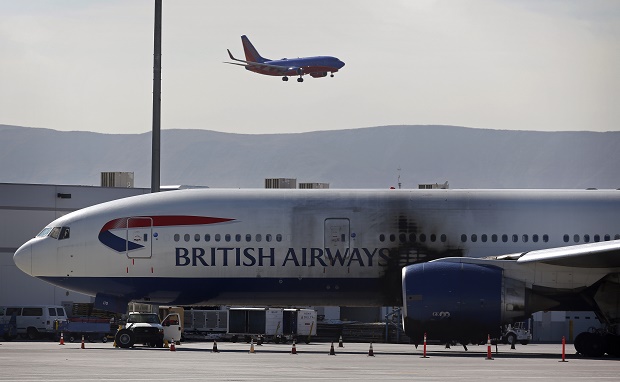
A damaged British Airways Boeing 777-200 sits at McCarran International Airport Wednesday, Sept. 9, 2015, in Las Vegas. An engine caught fire before takeoff Tuesday forcing the evacuation of the crew and passengers. AP
LAS VEGAS — Passengers saw flames, heard blasts and smelled burning rubber on the runway. Some were already settled in for the long flight to London and didn’t wait to grab their shoes before dashing toward the inflatable slides.
British Airways Flight 2276 was accelerating for takeoff Tuesday when one of its engines caught fire, forcing the plane’s 157 passengers and 13 crew members to escape on its emergency slides. They then rushed across the hard, hot tarmac, unsure if they were fleeing a bomb or a blown tire.
READ: British Airways flight catches fire on Las Vegas runway
“Everyone was screaming, ‘Just keep on running!'” said passenger Karen Bravo, a 60-year-old Las Vegas resident who abandoned her flip-flops on the plane.
When they finally stopped running and turned around, they saw black smoke and flames.
“It was like a scene out of ‘Die Hard,'” Bravo said.
As bad as it looked, it could have been much worse. The Boeing 777 came to a screeching halt, firefighters responded quickly, and the flames didn’t reach the plane’s full fuel tank or breach the cabin.
The passengers and crew all made it off the plane, and any injuries were minor — a result of the bumps, bruises and scrapes from sliding from an airplane. The 27 people sent to a hospital were treated and released the same day. They included all 13 crew members.
The ordeal began as the plane sped down the runway for takeoff.
With the aircraft traveling anywhere from 40 to 100 mph, the pilot brought it to an abrupt halt. “Mayday, mayday,” said the calm, deliberate voice from the plane’s cockpit to the air traffic control tower, requesting help with a fire.
“We are evacuating on the runway. We have a fire. I repeat. We are evacuating,” the voice said.
From the fire’s start to its quick end — and an evacuation in between — the whole dramatic scene lasted five minutes.
Fire officials and airline observers described the response as flawless, the result of daily training that made the Boeing 777’s rare blown engine seem routine. They also noted the number of passengers on the plane was far below its capacity of 275.
No one knows yet what caused the blaze, but investigators have arrived in Las Vegas to find out.
“We’re interested in the exact chain of events,” said National Transportation Safety Board spokesman Eric Weiss.
Terrorism is not suspected; airport director Rosemary Vassiliadis said Wednesday there was “no indication whatsoever” it was a factor.
The plane had two GE90 engines made by GE Aviation, and the company said heat distress was evident on the left side’s engine and fuselage.
The large plane was built in 1998 and registered to British Airways a year later. By the end of 2013, it had been flown for 76,618 hours, according to the British Civil Aviation Authority.
That’s about average for that model aircraft, said John Cox, an aviation safety consultant and a captain with US Airways for 23 years.
“It has a remarkably good safety record,” he said of the 777 model, first introduced in 1994.
“This is a highly unusual event to have an engine failure of this magnitude.”
Las Vegas’ airport is the ninth-busiest in the US and had nearly 43 million passengers last year. The airport has been taking steps to accommodate more international travelers seeking direct flights to Europe and Asia, including adding new gates to accommodate wide-body double-decker jets.